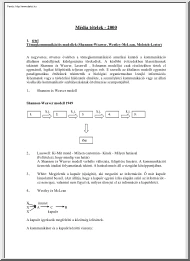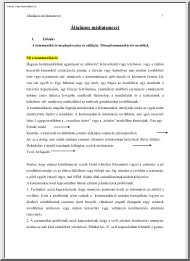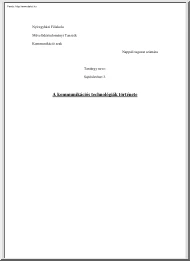Datasheet
Year, pagecount:2014, 4 page(s)
Language:English
Downloads:2
Uploaded:March 12, 2018
Size:604 KB
Institution:
-
Comments:
University of Minnesota Press
Attachment:-
Download in PDF:Please log in!
Comments
No comments yet. You can be the first!Most popular documents in this category
Content extract
Source: http://www.doksinet Isaac Rooks Book Review: Stephanie DeBoer, Coproducing Asia: Locating Japanese-Chinese Regional Film and Media University of Minnesota Press, 2014. $23.35 (paperback) The East Asian film and media coproductions central to Stephanie DeBoer’s Coproducing Asia: Locating Japanese-Chinese Regional Film and Media are more than an important business practice. As DeBoer explains, they “potentiated new forms of encounter, expression, and, ultimately, identity for the region.”1 This ambitious yet concise study charts the historic transformation of this technology of production. In addition to providing a detailed case study, Coproducing Asia develops a multiscalar framework for investigations of transnational film and media practices. This method accounts for transnational flows of media and capital and the negotiation of local interests necessary for regional economic and cultural exchange. DeBoer positions her work against accounts of regional media that
understand coproduction as a technology guiding “Asian film and media toward its inevitable emergence.”2 These interpretations suggest that coproductions will unavoidably supersede local productions, for good or ill, forming “a ‘new Asia’ of ever-expanding markets, economies, and platforms of exchange.”3 What chance do historic and political conflicts stand when faced 50 Making Difference Mike Dillon, editor, Spectator 35:1 (Spring 2015): 52-55 with producers’ borderless excitement “to take advantage of the resources of a new region ‘rising’ in more proximate economic and cultural exchange”?4 Proponents and critics of the rise of coproductions need to understand that these developments do not signify the inexorable progression towards an optimal production model. They are highly contingent and depend upon “often contradictory sentiments and competing desires.”5 Asian coproductions are dynamic assemblages of competing scales of production, mediating Cold War
and imperialist legacies. DeBoer describes coproductions that attempt to establish an Asian cultural bloc “as less a site of transformation than a site of negotiation.”6 Producers want this region to be a cooperative resource pool and marketplace; however, it remains unclear what form these regional connections will take and whom they will benefit. Within the resultant media products, competing regional visions emerge. Drawing on scholarship at the intersection of transnational media studies and cultural geography, DeBoer develops “a set of critical strategies and frameworks for understanding the uneven and ever-shifting negotiations at play Source: http://www.doksinet ROOKS in coproduction’s interface with regional cultural production.”7 DeBoer structures Coproducing Asia as a genealogical history. DeBoer’s method facilitates an investigation that addresses the subject’s “plural and sometimes contradictory past.”8 The book’s five chapters progress
chronologically from the 1950s to the 2000s, yet they do not suggest a clear and gradual evolution of industrial practice. Rather, each centers on production trends that provide “a set of critical and contextual lenses that mutually and contradictorily inform one another.”9 DeBoer’s concentration on Japanese and Chinese (PRC, Hong Kong, and Taiwan) media capitals provides necessary parameters for an ambitious project. Her approach to coproductions combines the methodologies of cultural and cultural industry studies. The result is not always an even balance. At times, DeBoer’s textual analysis feels supplementary to her elucidation of industrial maneuverings, the latter element being bolstered by extensive archival research and original interviews. Still, Coproducing Asia provides an important example for scholars interested in engaging the process and end result of media production. DeBoer makes a convincing case for the benefits of wedding such methods, as her critical system
attends to these coproductions’ construction of an Asian region and identity that is “both material and imaginary.”10 Given the book’s succinct presentation, DeBoer brings this framework to bear on an impressive amount of material. DeBoer’s considerations are wide-ranging, and she weaves them into her study in a manner that addresses the diverse factors impacting Asian media. Chapter One deals with the efforts of Japanese studios in the 50s and 60s to seek partnerships and markets throughout Asia, positioning themselves as a paragon “of modern and technologically rationalized filmmaking in East and Southeast Asia.”11 As Japan’s former colonies became desired markets, the specters of imperialism met developments in film technology and business. The Japanese-Hong Kong international romance films that were produced through these early efforts narratively engaged regional connectivity and mobility, and they mediated expansionist Japanese practices. DeBoer explicates this
moment through attentiveness to intra-regional business negotiations and close readings of coproduced texts. However, her analysis extends beyond the regional. It contextualizes these productions in Japan’s domestic media landscape and relevant global cultural flows, with particular attention to Hollywood’s influence on Japanese cinematic methods and narratives. The “strategy of ‘copying’” carries into Chapter Two.12 Japan’s Nikkatsu studios cribbed from successful Hollywood films to produce international espionage thrillers that commercially (and narratively) crossed international borders. Subsequently, from the 50s to the 70s, Hong Kong’s Shaw Brothers Studio worked with Japanese filmmakers and producers. Shaw Brothers drew on Japanese technical and narrative know-how to produce action films with a similarly wide appeal but a Chinese inflection, making films “exotic” enough to attract foreign audiences.13 These “copied” films destabilized static notions of
core-periphery regional relationships. Japan saw Hong Kong as a gateway for Southeast Asian distribution, while Hong Kong viewed Japan both as a resource upon which to draw and as a competitor to be surpassed. These cases also highlight how collaborative regional media balances “aspirations of allowing consolidation and difference.”14 These action movies relied on the local and unique for external appeal, yet they were produced under banners of regional unity. The use of coproductions to forge regional ties takes on greater significance in Chapter Three, which deals with “Sino-Japanese friendship” productions.15 These television events, produced from the late 70s to the 90s, sought to normalize Japan-China relations. Shot on location in a previously “closed” Mainland China, these programs made manifest cooperative production and visualized PRC’s reopening. These programs took advantage of television’s illusion of proximity and intimacy with depicted subjects in order to
foster a sense of regional connectivity. However, they simultaneously indulged desires for the unusual, using a visual style evocative of ethnographic or travel documentaries. Throughout the book, but in Chapter Three in particular, location shooting and the visualization of landscapes take on ideological significance. For example, during production of the historical documentary series The Silk Road (CCTV- MAKING DIFFERENCE 51 Source: http://www.doksinet COPRODUCING ASIA book review NHK; 1980), Chinese press reports worried that depictions of China’s eastern hinterlands made the country appear stuck in the past. There were even complaints of Japanese cinematographers filming setting suns, instead of rising ones (was China not a country on the rise?).16 These filmed landscapes, and the stories that played out in them, provided opportunities to narratively confront and/ or obfuscate “the ‘unimaginable pain’ of wartime violence and Cold War separation.”17 DeBoer explores
the way in which representations of seemingly timeless locations, mediated through the latest technology, engaged the past to address the present. Her analysis here is generally useful for media scholars interested in memory work and the legacies of colonial and imperialist domination. Chapter Four discusses omnibus films – episodic anthology features and film series linked thematically or narratively – produced in the 80s and 90s by Southeast Asian directors under the auspices of Japanese production companies. Through such endeavors, Japanese studios sought to create a PanAsian cultural sphere, with Japan as the organizing hub for the development of emergent film markets. As with other trends discussed by DeBoer, there is an inherent tension in these works. Japanese studios saw these productions as an opportunity to “introduce” the region to Japanese audiences. Producers wanted to coherently unify these diverse localities and to elide potential inflammatory issues, such as
inequitable regional development or imperialist legacies. At the same time, studios hoped to highlight elements that would be exotic to Japanese audiences. Despite these ideological constraints and obligations, the directors involved subverted and challenged these dominant structures by making films that spoke to local audiences. This chapter highlights DeBoer’s ability to analytically balance local, regional, and global factors, thereby avoiding privileging one arena of production and circulation at the expense of the others; to do so would risk ignoring the way these films negotiate varied interests and resonated in different registers. Coproducing Asia presents the region as a construct in a constant state of becoming, and Chapter Five deals with recent cinematic coproductions responding to the increased access other regional players have had to PRC in the 2000s. New markets, resources, and locations have reconfigured preexisting coproduction structures and created new
possibilities for the formation of a Pan-Asian cinema. DeBoer reads historic epics focused on Chinese reunification, like Hero (Zhang Yimou; 2002) and Battle of Wits ( Jacob Cheung; 2006), as texts in which contemporary issues of regional consolidation were enacted allegorically. While Chapter Five’s main topic is big-budget blockbusters, DeBoer ends by considering the alternative strategies of medium- to small-scale coproductions. While this offers a more rounded picture of the industry, this consideration of different production scales feels less developed than the chapter’s primary focus. DeBoer’s work offers an invaluable resource for scholars interested in historic and contemporary configurations of East Asian cinema. Regardless of their geographic focus, scholars interested in the mediated negotiation of regional relations should familiarize themselves with DeBoer’s contribution. Coproducing Asia sometimes struggles in its attempts to engage the complex interactions of
local, regional, and global factors evenly. Nonetheless, DeBoer’s book is impressive in how it balances these interests and blends methodologies productively, offering a model of wellrounded media scholarship that draws great insights from its inquiries into both creative and industrial matters. Isaac Rooks is a Graduate School Fellow and Ph.D Student in the Critical Studies Division of USC’s School of Cinematic Arts. His research centers on depictions of landscapes and animals in film, particularly in horror fiction. Notes 1 Stephanie DeBoer, Coproducing Asia: Locating Japanese-Chinese Regional Film and Media (Minneapolis: University of Minnesota Press, 2014), 2. 2 Ibid., 5 52 SPRING 2015 Source: http://www.doksinet ROOKS 3 Ibid., 3 4 Ibid., 184 5 Ibid., 14 6 Ibid., 11 7 Ibid., 7 8 Ibid., 16 9 Ibid., 19 10 Ibid., 15 11 Ibid., 30 12 Ibid., 57 13 Ibid., 64 14 Ibid., 147 15 Ibid., 86 16 Ibid., 95 17 Ibid., 86 MAKING DIFFERENCE 53
understand coproduction as a technology guiding “Asian film and media toward its inevitable emergence.”2 These interpretations suggest that coproductions will unavoidably supersede local productions, for good or ill, forming “a ‘new Asia’ of ever-expanding markets, economies, and platforms of exchange.”3 What chance do historic and political conflicts stand when faced 50 Making Difference Mike Dillon, editor, Spectator 35:1 (Spring 2015): 52-55 with producers’ borderless excitement “to take advantage of the resources of a new region ‘rising’ in more proximate economic and cultural exchange”?4 Proponents and critics of the rise of coproductions need to understand that these developments do not signify the inexorable progression towards an optimal production model. They are highly contingent and depend upon “often contradictory sentiments and competing desires.”5 Asian coproductions are dynamic assemblages of competing scales of production, mediating Cold War
and imperialist legacies. DeBoer describes coproductions that attempt to establish an Asian cultural bloc “as less a site of transformation than a site of negotiation.”6 Producers want this region to be a cooperative resource pool and marketplace; however, it remains unclear what form these regional connections will take and whom they will benefit. Within the resultant media products, competing regional visions emerge. Drawing on scholarship at the intersection of transnational media studies and cultural geography, DeBoer develops “a set of critical strategies and frameworks for understanding the uneven and ever-shifting negotiations at play Source: http://www.doksinet ROOKS in coproduction’s interface with regional cultural production.”7 DeBoer structures Coproducing Asia as a genealogical history. DeBoer’s method facilitates an investigation that addresses the subject’s “plural and sometimes contradictory past.”8 The book’s five chapters progress
chronologically from the 1950s to the 2000s, yet they do not suggest a clear and gradual evolution of industrial practice. Rather, each centers on production trends that provide “a set of critical and contextual lenses that mutually and contradictorily inform one another.”9 DeBoer’s concentration on Japanese and Chinese (PRC, Hong Kong, and Taiwan) media capitals provides necessary parameters for an ambitious project. Her approach to coproductions combines the methodologies of cultural and cultural industry studies. The result is not always an even balance. At times, DeBoer’s textual analysis feels supplementary to her elucidation of industrial maneuverings, the latter element being bolstered by extensive archival research and original interviews. Still, Coproducing Asia provides an important example for scholars interested in engaging the process and end result of media production. DeBoer makes a convincing case for the benefits of wedding such methods, as her critical system
attends to these coproductions’ construction of an Asian region and identity that is “both material and imaginary.”10 Given the book’s succinct presentation, DeBoer brings this framework to bear on an impressive amount of material. DeBoer’s considerations are wide-ranging, and she weaves them into her study in a manner that addresses the diverse factors impacting Asian media. Chapter One deals with the efforts of Japanese studios in the 50s and 60s to seek partnerships and markets throughout Asia, positioning themselves as a paragon “of modern and technologically rationalized filmmaking in East and Southeast Asia.”11 As Japan’s former colonies became desired markets, the specters of imperialism met developments in film technology and business. The Japanese-Hong Kong international romance films that were produced through these early efforts narratively engaged regional connectivity and mobility, and they mediated expansionist Japanese practices. DeBoer explicates this
moment through attentiveness to intra-regional business negotiations and close readings of coproduced texts. However, her analysis extends beyond the regional. It contextualizes these productions in Japan’s domestic media landscape and relevant global cultural flows, with particular attention to Hollywood’s influence on Japanese cinematic methods and narratives. The “strategy of ‘copying’” carries into Chapter Two.12 Japan’s Nikkatsu studios cribbed from successful Hollywood films to produce international espionage thrillers that commercially (and narratively) crossed international borders. Subsequently, from the 50s to the 70s, Hong Kong’s Shaw Brothers Studio worked with Japanese filmmakers and producers. Shaw Brothers drew on Japanese technical and narrative know-how to produce action films with a similarly wide appeal but a Chinese inflection, making films “exotic” enough to attract foreign audiences.13 These “copied” films destabilized static notions of
core-periphery regional relationships. Japan saw Hong Kong as a gateway for Southeast Asian distribution, while Hong Kong viewed Japan both as a resource upon which to draw and as a competitor to be surpassed. These cases also highlight how collaborative regional media balances “aspirations of allowing consolidation and difference.”14 These action movies relied on the local and unique for external appeal, yet they were produced under banners of regional unity. The use of coproductions to forge regional ties takes on greater significance in Chapter Three, which deals with “Sino-Japanese friendship” productions.15 These television events, produced from the late 70s to the 90s, sought to normalize Japan-China relations. Shot on location in a previously “closed” Mainland China, these programs made manifest cooperative production and visualized PRC’s reopening. These programs took advantage of television’s illusion of proximity and intimacy with depicted subjects in order to
foster a sense of regional connectivity. However, they simultaneously indulged desires for the unusual, using a visual style evocative of ethnographic or travel documentaries. Throughout the book, but in Chapter Three in particular, location shooting and the visualization of landscapes take on ideological significance. For example, during production of the historical documentary series The Silk Road (CCTV- MAKING DIFFERENCE 51 Source: http://www.doksinet COPRODUCING ASIA book review NHK; 1980), Chinese press reports worried that depictions of China’s eastern hinterlands made the country appear stuck in the past. There were even complaints of Japanese cinematographers filming setting suns, instead of rising ones (was China not a country on the rise?).16 These filmed landscapes, and the stories that played out in them, provided opportunities to narratively confront and/ or obfuscate “the ‘unimaginable pain’ of wartime violence and Cold War separation.”17 DeBoer explores
the way in which representations of seemingly timeless locations, mediated through the latest technology, engaged the past to address the present. Her analysis here is generally useful for media scholars interested in memory work and the legacies of colonial and imperialist domination. Chapter Four discusses omnibus films – episodic anthology features and film series linked thematically or narratively – produced in the 80s and 90s by Southeast Asian directors under the auspices of Japanese production companies. Through such endeavors, Japanese studios sought to create a PanAsian cultural sphere, with Japan as the organizing hub for the development of emergent film markets. As with other trends discussed by DeBoer, there is an inherent tension in these works. Japanese studios saw these productions as an opportunity to “introduce” the region to Japanese audiences. Producers wanted to coherently unify these diverse localities and to elide potential inflammatory issues, such as
inequitable regional development or imperialist legacies. At the same time, studios hoped to highlight elements that would be exotic to Japanese audiences. Despite these ideological constraints and obligations, the directors involved subverted and challenged these dominant structures by making films that spoke to local audiences. This chapter highlights DeBoer’s ability to analytically balance local, regional, and global factors, thereby avoiding privileging one arena of production and circulation at the expense of the others; to do so would risk ignoring the way these films negotiate varied interests and resonated in different registers. Coproducing Asia presents the region as a construct in a constant state of becoming, and Chapter Five deals with recent cinematic coproductions responding to the increased access other regional players have had to PRC in the 2000s. New markets, resources, and locations have reconfigured preexisting coproduction structures and created new
possibilities for the formation of a Pan-Asian cinema. DeBoer reads historic epics focused on Chinese reunification, like Hero (Zhang Yimou; 2002) and Battle of Wits ( Jacob Cheung; 2006), as texts in which contemporary issues of regional consolidation were enacted allegorically. While Chapter Five’s main topic is big-budget blockbusters, DeBoer ends by considering the alternative strategies of medium- to small-scale coproductions. While this offers a more rounded picture of the industry, this consideration of different production scales feels less developed than the chapter’s primary focus. DeBoer’s work offers an invaluable resource for scholars interested in historic and contemporary configurations of East Asian cinema. Regardless of their geographic focus, scholars interested in the mediated negotiation of regional relations should familiarize themselves with DeBoer’s contribution. Coproducing Asia sometimes struggles in its attempts to engage the complex interactions of
local, regional, and global factors evenly. Nonetheless, DeBoer’s book is impressive in how it balances these interests and blends methodologies productively, offering a model of wellrounded media scholarship that draws great insights from its inquiries into both creative and industrial matters. Isaac Rooks is a Graduate School Fellow and Ph.D Student in the Critical Studies Division of USC’s School of Cinematic Arts. His research centers on depictions of landscapes and animals in film, particularly in horror fiction. Notes 1 Stephanie DeBoer, Coproducing Asia: Locating Japanese-Chinese Regional Film and Media (Minneapolis: University of Minnesota Press, 2014), 2. 2 Ibid., 5 52 SPRING 2015 Source: http://www.doksinet ROOKS 3 Ibid., 3 4 Ibid., 184 5 Ibid., 14 6 Ibid., 11 7 Ibid., 7 8 Ibid., 16 9 Ibid., 19 10 Ibid., 15 11 Ibid., 30 12 Ibid., 57 13 Ibid., 64 14 Ibid., 147 15 Ibid., 86 16 Ibid., 95 17 Ibid., 86 MAKING DIFFERENCE 53





